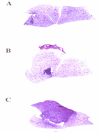Development of a model of focal pneumococcal pneumonia in young rats
- PMID: 14741053
- PMCID: PMC333431
- DOI: 10.1186/1476-8518-2-2
Development of a model of focal pneumococcal pneumonia in young rats
Abstract
BACKGROUND: A recently licensed pneumococcal conjugate vaccine has been shown to be highly effective in the prevention of bacteremia in immunized children but the degree of protection against pneumonia has been difficult to determine. METHODS: We sought to develop a model of Streptococcus pneumoniae pneumonia in Sprague-Dawley rats. We challenged three-week old Sprague-Dawley pups via intrapulmonary injection of S. pneumoniae serotypes 3 and 6B. Outcomes included bacteremia, mortality as well histologic sections of the lungs. RESULTS: Pneumonia was reliably produced in animals receiving either 10 or 100 cfu of type 3 pneumococci, with 30% and 50% mortality respectively. Similarly, with type 6B, the likelihood of pneumonia increased with the inoculum, as did the mortality rate. Prophylactic administration of a preparation of high-titered anticapsular antibody prevented the development of type 3 pneumonia and death. CONCLUSION: We propose that this model may be useful for the evaluation of vaccines for the prevention of pneumococcal pneumonia.
Figures

References
-
- WHO meeting on maternal and neonatal pneumococcal immunization. Wkly Epidemiol Rec. 1998;73:187–188. - PubMed
-
- Black S, Shinefield H, Fireman B, Lewis E, Ray P, Hansen JR, Elvin L, Ensor KM, Hackell J, Siber G, Malinoski F, Madore D, Chang I, Kohberger R, Watson W, Austrian R, Edwards K. Efficacy, safety and immunogenicity of heptavalent pneumococcal conjugate vaccine in children. Northern California Kaiser Permanente Vaccine Study Center Group [In Process Citation] Pediatr Infect Dis J. 2000;19:187–195. doi: 10.1097/00006454-200003000-00003. - DOI - PubMed
-
- Frimodt-Moller N. The mouse peritonitis model: present and future use. J Antimicrob Chemother. 1993;31 Suppl D:55–60. - PubMed
LinkOut - more resources
Full Text Sources

